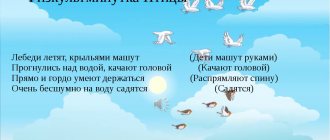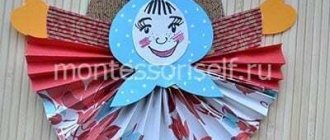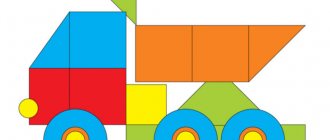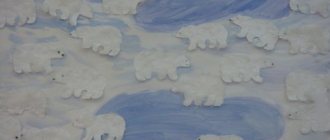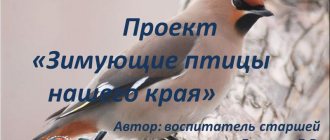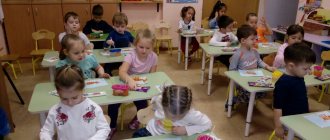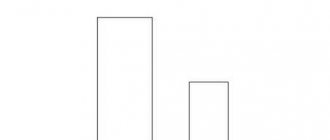Poultry
As a rule, children's acquaintance with the world of birds begins with poultry, because this is most expedient. Therefore, already in kindergarten, children know perfectly well what poultry is and what they look like.
It is advisable to start getting acquainted with this type of creativity with familiar images, so it will be much easier for the child to consolidate the acquired knowledge in memory.
Poultry includes ducks, chickens, geese, turkeys; all of them are quite easy to make from paper, cardboard or other improvised means that you decide to use in the craft.
The easiest way to assemble a craft is from paper or cardboard, because it is a hard material from which absolutely any shape can be cut.
For the craft you will need:
- Base (colored cardboard)
- Watercolor or gouache
- Plasticine
- Glue stick
- Cotton pads, napkins
Assembly
Let's start assembling the small chicken.
The assembly instructions are very simple; the body will be a solid cotton pad, which needs to be glued to the base using a glue stick.
Next, to complement the image, giving it an increasingly realistic look, you need to place another cotton pad a little higher; it will serve as the head of the craft. Please note that these 2 cotton pads should be touching each other.
At this stage it is necessary to paint the workpiece using yellow paint. It is worth remembering that cotton pads absorb moisture well, so you should try to squeeze out the brush, leaving only paint with less water on it.
Once they are carefully painted yellow, you need to give them some time for the paint to dry.
When it is dry, you can begin further assembly. To make chicken wings, you need to take a new cotton pad and use scissors to cut it into 2 equal parts. Only one half is needed for this craft.
It should be placed on the body so that the rounded part of the disk is at the bottom. The part of the cotton pad itself should be located exactly in the middle of the body.
The wing also needs to be carefully glued, wait until the glue dries, and then paint it yellow, like the rest of the parts. All that remains is to make the beak, eyes and legs.
For the beak and paws, red or burgundy plasticine is used. A part of the desired shape is carefully molded from it, after which it is glued to the base with a slight movement.
To make an eye, it is recommended to use a black felt-tip pen; you just need to gently press once on the desired place, and an even circle will be ready.
This completes the assembly of a simple craft; the time spent on manufacturing and combining all the parts does not exceed 30 minutes, which is very convenient.
MAGAZINE Preschooler.RF
Integrated lesson (speech development + application) for middle group children on the topic: “Spring. Migratory birds"Municipal budgetary preschool educational institution "Kindergarten No. 250" of a combined type
Completed and conducted by: teacher Keritsa Olga Aleksandrovna Novokuznetsk
Children enter the group and stand in a semicircle near paintings on the theme “SPRING” . I ask questions: What time of year? (spring). What was it? (winter) Will it be? (summer). What are the signs of spring that you know? (the sun is shining and warming, the snow is melting, streams are running, birds are chirping, the first flowers have bloomed: snowdrops, mother and stepmother; buds have appeared on the trees, insects have awakened).
Think and tell me: are there more or fewer birds? (more). The children's reasoning, I summarize: In the spring, birds return home from hot countries because it has become warm outside. Bugs, worms, and insects appeared. There is more food for birds. The birds are happy to return home, they chirp happily. Birds sing best in the spring. In the morning they wake us up with their singing. Having flown home, the birds look for houses or build nests.
What are the names of the birds that fly to us from hot countries? (migratory) And those who did not fly away, but spent the winter with us? (wintering).
Look, here are pictures of wintering and migratory birds. Place migratory birds on the top shelf, and wintering birds on the bottom shelf. On the top shelf we have: starling, swallow, rook, and on the bottom: sparrow, dove, tit. What are the names of the birds on the bottom shelf? (wintering). What are the names of the birds on the top shelf? (migratory).
Let's play a game with you - round dance "Sparrow"
Among the white doves, children walk in a circle, depicting a nimble sparrow galloping. Pigeons; in the center one child jumps like a sparrow. Sparrow - bird, Children stand facing in a circle
Gray shirt. They walk at a slow pace. Respond, sparrow, the sparrow is trying to “fly out.” Fly out, don’t be timid. From the circle; the pigeons, holding hands, do not let him go.
Children play 2-3 times and sit on chairs in a semicircle, opposite pictures with birds. I’m making a riddle, I ask you to show me and tell me the answer:
I am agile, light-winged, My tail is forked, like a pitchfork. If I fly low, it means rain is nearby somewhere.
(martin)
I draw the children’s attention to the structure of a swallow: head, body, wings, tail, beak, legs, chest, abdomen. Show and name the parts of the body, what you think it eats, and where it lives. To summarize: the whole bird is black, only the breast is white, the swallow has a long tail, it bifurcates at the end, the tail is the most striking distinctive feature of the swallow. The swallow, like all birds, feeds on bugs, butterflies, worms, and grains. She makes a nest out of clay and small twigs. Swallows raise their chicks in such nests.
Now guess another riddle: On a pole there is a happy house with a small round window so that the children can fall asleep
The house is shaking in the wind. The father is singing on the porch - He is both a pilot and a singer.
(starling).
Describe the starling using the swallow as an example (children's answers, writing short stories). The plumage is black with a metallic sheen; the beak is yellow, sharp and rather long, slightly curved down; the wings are long and pointed, the tail is short.
The starling, like other birds, feeds on bugs, spiders, and pecks grains. Therefore, in winter there is no food for him in our area and he, like the swallow, flies south. The starling returns in early spring. Everyone knows and loves starlings; their arrival means the coming of spring for people. The starling can sing in a very unusual way, imitating in his singing even the croaking of frogs or the barking of dogs. They also imitate the human voice well. People like starlings. To ensure that starlings settle close to people, special houses are built for them in the spring. Who knows what they are called? (birdhouses).
I suggest you consider a birdhouse: it looks like a house, with a roof and a round hole called a LETOK. It is made round so that birds can fly easily and not get scratched. Come on, you and I will make birdhouses and attach them to this tree (I’m bringing in a picture with a large image of a tree). Tell me, will we attach our birdhouses high or low? (high so that the cats don’t get the boys).
Let's go to the seats at the tables and see what parts the birdhouse will consist of. On the tables in patches are large brown and yellow squares, small blue squares, scissors, glue, and napkins. What do you think can be made from a brown rectangle? (the house itself), and from yellow? (fold diagonally, smooth the fold and cut to form a triangular roof). How to make a round entrance? (smoothly cut the corners of a small square, starting from the middle of one side to the middle of the other, and so on in a circle). Let's remember how we will glue? (we place the paper color down, coat the entire surface of the part, carefully apply it and press it with a napkin for better gluing and removal of glue residues). Whoever made the birdhouse can come up and glue it to a tree branch.
Well done! Today you did a good job and made a lot of birdhouses for starlings. Look, I have little birdhouses, you just need to color them, cut them out and glue them next to your birdhouse. Want to? (yes) We will do this a little later, but for now, the lesson is over. Thanks to all.
| Next > |
Chickens and geese
These poultry have abundant plumage, which also needs to be indicated on the applique. Depending on the age of the child, applique with these birds can be of different types.
For the little ones, the same approach is used as when making chicken. As a final step, the child will need to place cotton wool on it, which will imitate plumage.
For older children, for example, for the second or third year of being in kindergarten, pre-prepared bird templates are used. They are printed on paper and given to children. And they, in turn, must correctly fill the template with cotton wool where it is needed.
The remaining parts should be colored with felt-tip pens, pencils or colored pens, whichever is more convenient for you.
For this craft you will need:
- Glue stick
- Outline drawings of birds
- Paints, pencils, pens
- cotton wool
- Scissors

